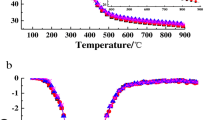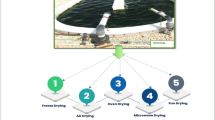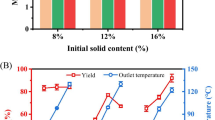Abstract
Algal biofuels serve as a promising alternative energy source for liquid fuels. However, one of the bottlenecks in the conversion of microalgae to biofuels is the drying process. A moisture content of at most 10 % is desired for algal biomass prior to oil extraction to maximise biofuel yield. Conventional means of drying results to longer drying time and uneven drying of algal biomass. This study investigated the drying characteristics of microwave for microalgae (Chlorella vulgaris). Three microwave intensity levels (300, 600, and 900 W) were considered to dry 10, 20, and 30 of algal mass. Page model gave a better fit on the moisture ratio with time of microwave drying than the exponential model. Furthermore, the specific energy requirement was computed, and a relationship was found between moisture ratio with power and mass. Fourier transform infrared spectroscopy results showed significant reduction of infrared signal intensities of the functional groups present in the algae after drying at higher microwave power level. It was concluded that the 20 W/g microwave drying setting gave a lower specific energy requirement with good quality of remaining high lipid content qualitatively. Furthermore, it was recommended to use gas chromatography mass spectroscopy to further quantify the algal lipids and other functional groups.






Similar content being viewed by others
References
Avagyan AB (2008) A contribution to global sustainable development: inclusion of microalgae and their biomass in production and bio cycles. Clean Technol Environ Policy 10(4):313–317
Balat M, Balat H (2010) Progress in biodiesel processing. Appl Energy 87:1815–1835
Becker EW, Venkataraman LV (1982) Biotechnology and exploitation of algae: the Indian approach. Deutsche Gesellschaft fur Technische Zusammenarbeit
Bennion EP, Ginosar DM, Moses J, Agblevor F, Quinn JC (2015) Lifecycle assessment of microalgae to biofuel: comparison of thermochemical processing pathways. Appl Energy 154:1062–1071
Brau JF, Morandin M, Berntsson T (2013) Hydrogen for oil refining via biomass indirect steam gasification: energy and environmental targets. Clean Technol Environ Policy 15(3):501–512
Brennan L, Owende P (2010) Biofuels from microalgae—a review of technologies forproduction, processing, and extractions of biofuels and co-products. Renew Sustain Energy Rev 14:557–577
Bulatov I, Klemeš JJ (2011) Clean fuel technologies and clean and reliable energy: a summary. Clean Technol Environ Policy 13(4):543–546
Chanrasekaran S, Ramanathan S, Basak T (2013) Microwave food processing—a review. Food Res Int 52:243–261
Chen CY, Yeh KL, Aisyah R, Lee DJ, Chang JS (2011) Cultivation, photobioreactor design and harvesting of microalgae for biodiesel production: a critical review. Bioresour Technol 102(1):71–81
Cheng J, Yu T, Li T, Zhou J, Cen K (2013) Using wet microalgae for direct biodiesel production via microwave irradiation. Bioresour Technol 131:531–535
Chisti Y (2007) Biodiesel from microalgae. Biotechnol Adv 25(3):294–306
Culaba AB, Tan RR, Biona JBM, Ubando AT, Lopez NSA, Tanchuco JQ, Garibay SS, Toledo NA, Jimenez CN, Pahila IG, Ami LS (2013) A mathematical model for the drying characteristics of microalgae (Tetraselmis sp.). Philippine Sci Lett 6(2)
Darvishi H, Azadbakht M, Rezaeiasl A, Farhang A (2013) Drying characteristics of sardine fish dried with microwave heating. J Saudi Soc Agric Sci 12(2):121–127
Datta AK, Davidson PM (2000) Microwave and radio frequency processing. J Food Sci 65:32–41
Dıaz GR, Martínez-Monzó J, Fito P, Chiralt A (2003) Modelling of dehydration–rehydration of orange slices in combined microwave/air drying. Innovat Food Sci Emerging Technol 4(2):203–209
Dissa AO, Bathiebo DJ, Desmorieux H, Coulibaly O, Koulidiati J (2011) Experimental characterization and modellling of thin layer direct solar drying of Amelie and Brooks mangoes. Energy 2011(36):2517–2527
Doymaz I (2004a) Convective air drying characteristics of thin layer carrots. J Food Eng 61:359–364
Doymaz I (2004b) Pretreatment effect on sun drying of mulberry fruits (Morus alba L.). J Food Eng 65:205–209
Doymaz İ (2005) Drying characteristics and kinetics of okra. J Food Eng 69(3):275–279
Du W, Li W, Sun T, Chen X, Liu D (2008) Perspectives for biotechnological production of biodiesel and impacts. Appl Microbiol Biotechnol 79(3):331–337
Ducut MRD, Villagracia ARC, Corpuz J, Arboleda NB Jr., David MY, Manrique RB, Ubando AT, Culaba AB (2014) Molecular dynamics study on the effects of varying temperature and pressure on phosphatidycholine lipids for microalgae drying. In Humanoid Nanotechnology, Information Technology, Communication and Control, Environment and Management (HNICEM), 2014 International Conference pp 1–4. IEEE, 2014
El-Sebaii AA, Aboul-Enein S, Ramadan MRI, El-Gohary HG (2002) Empirical correlations for drying kinetics of some fruits and vegetables. Energy 27(9):845–859
Ertekin C, Yaldiz O (2004) Drying of eggplant and selection of a suitable thin layer drying model. J Food Eng 63:349–359
Feng H, Tang J (1998) Microwave finish drying of diced apple slices in a spouted bed. J Food Sci 63(4):679–683
Glaser JA (2009) Carbon dioxide recycling. Clean Technol Environ Policy 11(3):253–257
Gogus F, Maskan M (1999) Water adsorption and drying characteristics of okra (Hibiscus esculentus L.). Drying Technol 17:883–894
Gouveia L, Oliveira AC (2009) Microalgae as a raw material for biofuels production. J Ind Microbiol Biotechnol 36(2):269–274
Grima EM, Medina AR, Giménez AG, Pérez JS, Camacho FG, Sánchez JG (1994) Comparison between extraction of lipids and fatty acids from microalgal biomass. J Am Oil Chem Soc 71(9):955–959
Grima EM, Belarbi EH, Fernández FA, Medina AR, Chisti Y (2003) Recovery of microalgal biomass and metabolites: process options and economics. Biotechnol Adv 20(7):491–515
Gupta O, Ahmed K, Shivhare US, Raghavan GSV (2002) Drying characteristics of red chilli. Drying Technol 20:1975–1987
Henderson SM, Pabis S (1961) Grain drying theory I. Temperature effect on drying coefficient. J Agric Eng Res 6(3):169–174
Ho Shih-Hsin et al (2014) Perspective on engineering strategies for improving biofuel production from micoalgae. Biotechnol Adv 32:1448–1459
Iqbal J (2012) Development of cost-effective and benign lipid extraction system for microalgae (Doctoral dissertation, Louisiana State University)
Koller M et al (2014) Microalgae as versatile cellular factories for valued products. Algal Res 6(2014):52–63
Koua KB, Fassinou WF, Gbaha P, Toure S (2009) Mathematical modelling of the thin layer solar drying of banana, mango and cassava. Energy 34(10):1594–1602
Lahsasni S, Kouhila M, Mahrouz M, Idlimam A, Jamali A (2004) Thin layer convective solar drying and mathematical modeling of prickly pear peel (Opuntia ficus indica). Energy 29(2):211–224
Lapinskiene A, Martinkus P, Rebzdaite V (2006) Eco-toxicological studies of diesel and biodiesel fuels in aerated soil. Environ Pollut 142:432–437
Lee JY, Yoo C, Jun SY, Ahn CY, Oh HM (2010) Comparison of several methods for effective lipid extraction from microalgae. Bioresour Technol 101:S75–S77
Lule F, Koyuncu T (2015) Convective and microwave drying characteristics of sorbus fruits (Sorbus domestica L.). Proc Soc Behav Sci 195:2634–2643
Manrique R, Villagracia ARC, Ubando AT, Corpuz J, Padama AA, David MY, Arboleda NB Jr, Culaba AB, Kasai H (2014) A molecular dynamics investigation of water migration in a lipid bilayer for microalgae drying. Philipp Sci Let 7(01):138–145
Maskan M (2000) Microwave/air and microwave finish drying of banana. J Food Eng 44(2):71–78
Maskan M (2001) Kinetics of colour change of kiwifruits during hot air and microwave drying. J Food Eng 48(2):169–175
Midilli A, Kucuk H (2003) Energy and exergy analyses of solar drying process of pistachio. Energy 28(6):539–556
Minowa T, Sawayama S (1999) A novel microalgal system for energy production with nitrogen cycling. Fuel 78(10):1213–1215
Nikolić S, Mojović L, Rakin M, Pejin D, Pejin J (2011) Utilization of microwave and ultrasound pretreatments in the production of bioethanol from corn. Clean Technol Environ Policy 13(4):587–594
O’Connell D, Savelski M, Slater CS (2013) Life cycle assessment of dewatering routes for algae derived biodiesel processes. Clean Technol Environ Policy 15(4):567–577
Özbek B, Dadali G (2007) Thin-layer drying characteristics and modelling of mint leaves undergoing microwave treatment. J Food Eng 83(4):541–549
Özdemir M, Devres YO (1999) The thin layer drying characteristics of hazelnuts during roasting. J Food Eng 42(4):225–233
Park KJ, Vohnikova Z, Brod FPR (2002) Evaluation of drying parameters and desorption isotherms of garden mint leaves (Mentha crispa L.). J Food Eng 51:193–199
Pokoo-Aikins G, Nadim A, El-Halwagi MM, Mahalec V (2010) Design and analysis of biodiesel production from algae grown through carbon sequestration. Clean Technol Environ Policy 12(3):239–254
Ponnuswamy I (2013) Isolation and characterization of green microalgae for carbon sequestration, waste water treatment and bio-fuel production. Int J Bio-Science Bio Technol 5(2):17–26
Prakash J, Pushparaj B, Carlozzi P, Torzillo G, Montaini E, Materassi R (1997) Microalgal biomass drying by a simple solar device. Int J Solar Energy 18(4):303–311
Rawat I, Kumar RR, Mutanda T, Bux F (2013) Biodiesel from microalgae: a critical evaluation from laboratory to large scale production. Appl Energy 103:444–467
Sarimeseli A (2011) Microwave drying characteristics of coriander (Coriandrum sativum L.) leaves. Energy Convers Manag 52(2):1449–1453
Show KY, Lee DJ, Tay JH, Lee TM, Chang JS (2015) Microalgal drying and cell disruption—recent advances. Bioresour Technol 184:258–266
Singh A, Olsen SI (2011) A critical review of biochemical conversion, sustainability and life cycle assessment of algal biofuels. Appl Energy 88:3548–3555
Soeder CJ, Pabst W (1975) Production, properties, preclinical and clinical testing of Scenedesmus 276-3a. The PAG Compendium, C-2, 2113. World Mark Press Ltd, New York
Soysal Y (2004) Microwave drying characteristics of parsley. Biosyst Eng 89(2):167–173
Soysal Y, Öztekin S, Eren Ö (2006) Microwave drying of parsley: modelling, kinetics, and energy aspects. Biosyst Eng 93(4):403–413
Stanier RY, Kunisawa R, Mandel M, Cohen-Bazire G (1971) Purification and properties of unicellular blue-green algae (order Chroococcales). Bacteriol Rev 35(2):171
Teo CL, Jamaluddin H, Zain NAM, Idris A (2014) Biodiesel production via lipase catalysed transesterification of microalgae lipids from Tetraselmis sp. Renew Energy 68:1–5
Toğrul İT, Pehlivan D (2002) Mathematical modelling of solar drying of apricots in thin layers. J Food Eng 55(3):209–216
Usub T, Lertsatitthankorn C, Poomsa-Ad N, Wiset L, Siriamornpun S, Soponronnarit S (2010) Thin layer solar drying characteristics of silkworm pupae. Food Bioprod Process 88(2):149–160
Varith J, Dijkanarukkul P, Achariyaviriya A, Achariyaviriya S (2007) Combined microwave-hot air drying of peeled longan. J Food Eng 81(2):459–468
Viswanathan T, Mani S, Das KC, Chinnasamy S, Bhatnagar A, Singh RK, Singh M (2012) Effect of cell rupturing methods on the drying characteristics and lipid compositions of microalgae. Bioresour Technol 126:131–136
Xu L, Brilman DWW, Withag JA, Brem G, Kersten S (2011) Assessment of a dry and a wet route for the production of biofuels from microalgae: energy balance analysis. Bioresour Technol 102(8):5113–5122
Yaldiz O, Ertekin C, Uzun HI (2001) Mathematical modeling of thin layer solar drying of sultana grapes. Energy 26(5):457–465
Yanfen L, Zehao H, Xiaoqian M (2012) Energy analysis and environmental impacts of Microalgal biofuel in China. Energy Policy 45:142–151
Zhu Liandong (2015) Biorefinery as a promising approach to promote microalgae industry: an innovative framework. Renew Sustain Energy Rev 41:1376–1384
Acknowledgments
This work is funded by the CHED-PHERNet Sustainability Studies Program of the Commission for Higher Education (CHED), Philippines. The authors are also grateful for the assistance of De La Salle University Mechanical Engineering Department and University of the Philippines Los Baños, Laguna. Parts of this work were carried out in the National Institute of Physics, University of the Philippines, Diliman, the Chemistry Department and the Physics Department of De La Salle University, and the School of Material Science Engineering of Universiti Malaysia Perlis.
Author information
Authors and Affiliations
Corresponding author
Rights and permissions
About this article
Cite this article
Villagracia, A.R.C., Mayol, A.P., Ubando, A.T. et al. Microwave drying characteristics of microalgae (Chlorella vulgaris) for biofuel production. Clean Techn Environ Policy 18, 2441–2451 (2016). https://doi.org/10.1007/s10098-016-1169-0
Received:
Accepted:
Published:
Issue Date:
DOI: https://doi.org/10.1007/s10098-016-1169-0




